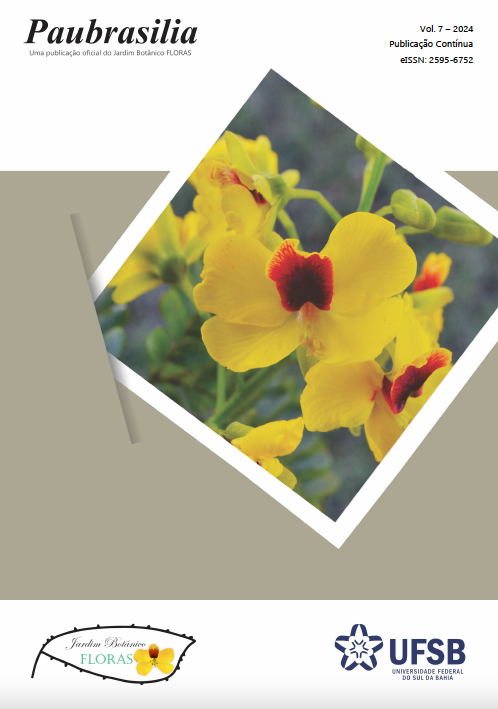Acanthaceae Juss. in the municipality of Vitória da Conquista, Bahia, Brazil
DOI:
https://doi.org/10.33447/paubrasilia.2024.e0148Keywords:
Asterids, Flora of Bahia, Lamiales, SemiaridAbstract
Acanthaceae is among the 12 most diverse angiosperm families, represented by 190 genera and estimated at 4,900 species, with pantropical distribution. The present work carried out a floristic survey of Acanthaceae in the municipality of Vitória da Conquista, Bahia, a region of ecological tension between the Caatinga and the Atlantic Forest. Twenty eight expeditions were carried out during the period from December/2021 to October/2023, covering the entire municipality, in addition to two extra collections in April/2024. These collections were fortnightly (outside the flowering season) and weekly (flowering season), and totaled 48 specimens sampled, deposited in the HUESBVC and HVC herbaria. Fourteen species were recorded for the municipality, namely: Aphelandra marginata, Clistax speciosus, Dicliptera ciliaris, Justicia laevilinguis, Lepidagathis nemoralis, Poikilacanthus bahiensis, Ruellia bahiensis, R. brevicaulis, R. brevifolia, R. ciliatiflora, R. geminiflora, R. paniculata, Ruellia sp., and Thyrsacanthus ramosissimus. Of the species collected, only D. ciliaris, R. brevifolia, and R. paniculata are not endemic to Brazil, and nine are new records for the municipality. Our results add knowledge about the flora of Vitória da Conquista and, consequently, Bahia and expand the collection of local herbaria.
Downloads
Published
How to Cite
Conference Proceedings Volume
Section
License
Copyright (c) 2024 Gabriel Chaves Soares, Claudenir Simões Caires

This work is licensed under a Creative Commons Attribution 4.0 International License.
By submitting manuscripts for publication in the journal, authors expressly agree to the following terms:
1 - Authors retain copyright on their manuscript and grant the right of first publication to the journal, with the work simultaneously licensed under the Creative Commons Attribution 4.0 International License, allowing it to be shared, as long as authorship and initial publication in Paubrasilia are acknowledged, with proper indication of volume, number (if any), page number (or elocation-id), and year in which the paper was published;
2 - Authors are allowed to enter into additional contracts separately, for non-exclusive distribution of the version of the paper published in Paubrasilia (e.g., publishing in an institutional repository or as a book chapter), provided that authorship and initial publication in this journal are acknowledged, with proper indication of volume, number (if any), page number (or elocation-id), and year in which the paper was published.











